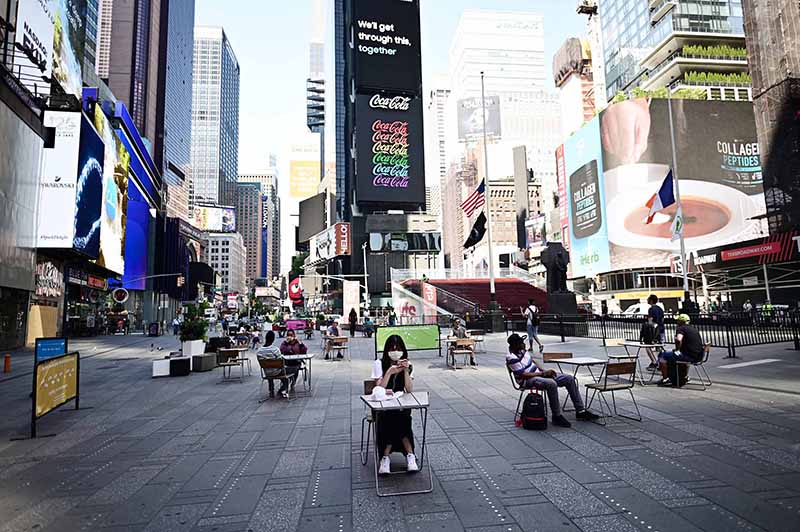
WASHINGTON: The United States on Monday passed the grim benchmark of 120,000 deaths from the coronavirus outbreak when it added another 425 fatalities in 24 hours, the Johns Hopkins University tally showed. The world’s largest economy is the hardest-hit country by the pandemic, with more than 2.31 million official cases - out of which about 640,000 people have fully recovered, according to the Baltimore-based institution at 8:30pm. The previous day’s toll of 305 deaths in 24 hours was one of the lowest in months, but numbers have tended to be lower during the weekend and just after, depending on the feedback from local health authorities.
Many states have largely lifted lockdown measures, and New York - the country’s epicenter for the pandemic — took a big step Monday by allowing non-essential businesses to reopen. But some 20 states, primarily in the south and west, have seen a rebound in infections. Among them, Florida passed 100,000 cases, of which nearly 3,000 were diagnosed on Monday alone, according to local health officials. President Donald Trump said Monday that the virus death toll in the US could surpass 150,000, though he insisted that two to four million lives would have been lost if the country had not taken steps to slow the spread of the disease.
Cases spike
Meanwhile, New York businesses opened their doors to returning waves of workers Monday as the city that was once the epicenter of the global pandemic marked an important milestone in its return to normalcy, even as other US states were seeing an alarming rise in COVID-19 cases. Nationwide, cases have been on the rise for the past two weeks following a long plateau in the spring, with California hitting levels of new infections not seen since March and Florida passing the 100,000 cases benchmark on Monday. President Donald Trump acknowledged that the US death toll - which has surpassed 120,000 - could reach 150,000 people. “It could go beyond that,” he said.
But for many in hard-hit New York, where more than 20,000 people succumbed to the disease, the return to normal meant resuming their small everyday rituals. For some, that meant getting a haircut. “I’ve been cutting it myself and doing a very bad job, so I was very excited to see (the barber),” said Jeremiah Zinn, a man in his 50s who was the first client to walk through the door at Benny’s Barbershop in Brooklyn. Yury Ykubov, the owner, told AFP he had opened the shop six months prior, and negotiated with the landlord to make rent during the lockdown.
Ykubov himself contracted COVID-19 but, like the city itself, has recovered and has antibodies for protection. But all the barbers in his shop took online courses on how to be safe, which included using special gowns, wearing masks, and no blow-drying. “I’m slightly nervous, like it’s the first day I come to work, the first day somebody hired me,” he laughed. In Manhattan, Sam Karalis, owner of The Windsor Florist, said his business was one of the lucky ones to have survived with the help of the government and his landlord. He was relieved to be able to open his doors to paying customers. “If you can’t look at the stuff, you can’t really buy it,” he said.
Nationwide cases rising
Statewide, Governor Andrew Cuomo reported 10 new deaths Sunday while the rate of positive test results has fallen to one percent - which has paved the way for incremental lifting of restrictions. New York City is now in the second of its four-phase reopening, which began two weeks ago when construction and industries were allowed to resume working. But the picture is far less positive in other parts of the United States, with the virus spiking in several states despite predictions that summer heat, humidity and bright sunlight would limit its spread. Cases were soaring in California, Texas, Arizona and in the Midwestern state of Missouri. In Florida, which reopened bars and restaurants earlier this month, emergency physician Rajiv Bahl said cases were rising across age groups.
“Personally, I am seeing more patients who are in their 20s, 30s, and 40s with upper respiratory symptoms than I did before,” he told AFP. “While it is not exactly known why this is the case, it may be because of the opening of bars and restaurants,” he added, with service industry workers accounting for a high volume of the cases. The Sunshine State saw almost 3,000 new cases on Monday, according to the latest official data, and Bahl urged would-be tourists to think carefully about their plans. “You may want to rethink mass gatherings and opt for more isolated adventures such as national parks, isolated beaches, or enjoying a pool with more strict distancing rules,” he said.
‘No second wave’
Top officials from the Trump administration, meanwhile, continued to downplay the severity of the pandemic, a nearly constant theme since the virus was first reported in the United States in January. “There is no second wave coming,” White House economic advisor Larry Kudlow told CNBC, adding that lawmakers will likely present another stimulus package by the end of next month. At a campaign rally in Tulsa, Oklahoma on Saturday, President Trump said he wanted to slow down testing, on grounds it was making the United States look bad. Former FDA Commissioner Scott Gottlieb, however, told CBS News on Sunday: “We’re seeing the positivity rates go up.
“That’s a clear indication that there’s now community spread underway. And this isn’t just a function of testing more.” Trump’s campaign announced Monday that two more staffers who helped organize the Tulsa rally had tested positive for coronavirus, taking the total number to eight. It said the two attended the rally — but “were wearing masks during the entire event.”—Agencies










